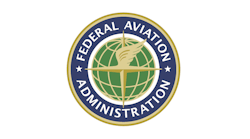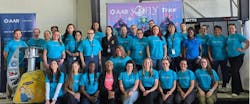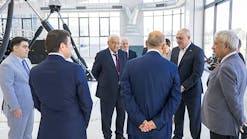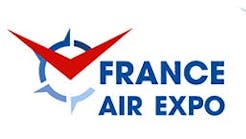25 Years: Then and Now: Human Factors Training: A Look Back and Forward
Bill Johnson looks back on his early involvement with human factors training, but he focuses on the aviation maintenance human factors that have evolved for 25+ years, since the late '80s. He shows a clear pattern and content that has changed focus from individual fundamental knowledge to current integrated organizational safety culture.
Maintenance human factors training starts in 1988
The FAA hosted its first Human Factors in Aviation Maintenance conference in 1988. That’s slightly over 25 years ago. Those annual U.S./International meetings provided extensive industrywide education and information exchange through 2011.
Company specific human factors training started in 1990, when Continental Airlines started offering a crew resource management (CRM) class to the engineering department. The course contained selected portions of the flight crew training materials that focused on valuable topics like communication and teamwork. About the same time US Air (now Airways) also initiated a class. Within a short time KLM, British Airways, Lufthansa, and others initiated selected human factors training in engineering. By the mid-'90s topics like Swiss Cheese (Reason), Dirty Dozen (Dupont), and PEAR (Johnson and Maddox) became standard fare for engineering HF courses. By that time ICAO and the Joint Aviation Authorities (now EASA) had formal guidance and recommendations for the content of such training. By 2000, various regulations emerged and were especially significant when the EASA regulations were issued in 2002. The FAA, in lieu of regulations, relied on the guidance from a very robust HF research program starting in 1988.
There are at least four phases that represent the 25-year existence of maintenance human factors training. The phases are based on who/what is the primary focus. That focus includes the following: 1. Individual worker understanding of human factors challenges; 2. Individual manager understanding of human factors challenges; 3. Senior management and organizational commitment to addressing human factors challenges; and 4. Organizational integration of human factors with safety management and safety culture.
Traditional curricula and focus
Initial human factors courses focused knowledge of human factors. Such knowledge could usually be assessed with a written exam based on the EASA Module 9 (see Table 1), affecting EASA Parts 66, 145, 147, and others. These are important topics because engineering personnel must understand and appreciate their own human strengths and weaknesses in order to apply human factors principles to the work environment. Some have compared these to the basics fundaments of flight including lift, drag, weight and balance, etc. You must know the fundamentals in order to apply them at work.
TABLE 1. Traditional EASA Module 9 Topics
9.1 General
9.2 Human Performance and Limitations
9.3 Social Psychology
9.4 Factors Affecting Performance
9.5 Physical Environment
9.6 Tasks
9.7 Communication
9.8 Human Error
9.9 Hazards in the Workplace
It is important that everyone working in maintenance is cognizant of these fundaments. That includes all managers. National Aviation Authorities, who have human factors regulations, require that the training is extended to the highest ranking management personnel.
Module 9 requirements have been voluntarily extended by many organizations who have recognized the potential and demonstrated safety and financial payback. These requirements are also expanding as regulations. For example, EASA has proposed (NPA 2013-19) to match SMS and enhance Module 9 by adding such topics as: organizational error, risk management, occurrence reporting, safety culture, and just culture.
From general HF knowledge to application in the workplace
Over the past 25 years human factors issues have become a familiar topic and vocabulary for engineers/mechanics worldwide. Today’s workers have received the Module 9 topics in school, in general employee training, and in selected recurrent training. Now they would likely benefit from new topics or in a more advanced version of the familiar Module 9 topics. To prepare for this article I created a possible listing of new topics for engineering HF training. I sent the list to a selected international group comprised of regulators, airlines, MROs, manufacturers, and notable consultants. The response was fast and included topics shown in Table 2. It is divided into two sections to include: Expanded Treatment of Current Topics and New Topics. These are the topics that will convert maintenance human factors challenges into organizational solutions. This information is not measured by a written test but, instead, by organizational actions that have a positive effect on key performance indicators.
Table 2: Expanded and New Topics/Subtopics for HF Training
Expanded topics/subtopics:
1. Safety culture and motivation
2. The power of the individual in safety culture
3. Safety culture leadership
4. Review of fundamentals like PEAR, Dirty Dozen, Swiss Cheese
5. Personal responsibility for: Fitness for duty, especially fatigue self-reporting
6. Using technical publications, job cards, etc.
7. Professional ethics and pride in workmanship
8. Additional physiology
9. Crew resource management (team working between mechanics, between mechanics and flight crew and between mechanics and flight operations and maintenance control.
New topics/subtopics:
1. SMS intro to include risk assessment and fundamentals of Threat and Error Management
2. Voluntary Reporting of error, including what to report (WIIFM?)
3. Emphasis that workers may know the hazards better than management
4. Peer to peer assessments and coaching like Maintenance and Ramp LOSA
5. Showing how safety data are used
6. Showing the safety and cost return on safety interventions (from employee data)
7. Generation Thinking/Communication
8. Social Media and Work
HF training evolution
The topics of Module 9 remain relevant. The same holds true for the 12 most common contributing factors to human error, still required by Transport Canada regulations. That does not mean that it is fine to use the same slides, movies, and other media/war stories that were created in the early nineties. In fact, such media and training methods could render relevant topics to irrelevant. When the slides and media are older than some of the students it is likely overdue for new methods. As an example, Lufthansa Technical Training redesigned and launched some of their HF training as an Apple Application. FAA stepped up with modern web-based fatigue awareness training program and new video (Grounded) www.hfskyway.faa.gov. Perhaps the best example of new Engineering HF training is the multimedia package developed by the Civil Aviation Safety Authority of Australia. It is titled Safety Behaviours – Human Factors for Engineers. It is available at www.casa.gov.au/hf. That program is described in Aircraft Maintenance Technology, September 2013. It is also on the FAA web site at www.hfskyway.faa.gov. Finally, there are many excellent third parties offering HF training. Be sure to ask about the age of their materials and media before signing a contract.
25-year progress
In current aviation maintenance circles the term “human factors” is a household word. That was not true in 1988. The value and importance of human factors training is no longer debated. The only debate now is how to ensure that the training and application remains relevant and high value in modern aviation maintenance work environments.
Acknowledgements*
The author acknowledges the many industry professionals that contributed to the list of expanded and new topics/subtopics. Portions of this work are reported in the International Federation of Airworthiness News (Winter 2013) and the FAA Human Factors Newsletter.
Dr. William Johnson is the FAA Chief Scientific and Technical Advisor for Human Factors in Aircraft Maintenance Systems. Johnson is a member of the Human Factors Advisory Group to the European Aviation Safety Agency (EASA).






